Research Article
Volume 1 Issue 3 - 2017
Fetal Differentiation of the Ileum of one Humped Camel (Camelus dromedarius):A Histomorphology
1Department of Veterinary Anatomy, Usmanu Danfodiyo University, Sokoto
2Department of Theriogenology and Animal production, Usmanu Danfodiyo University, Sokoto, Nigeria
2Department of Theriogenology and Animal production, Usmanu Danfodiyo University, Sokoto, Nigeria
*Corresponding Author: Dr. A Bello, Department of Veterinary Anatomy, Usmanu Danfodiyo University, Sokoto.
Received: October 04, 2016; Published: July 24, 2017
Abstract
An embryonic developmental study was conducted on the ileum of 35 foetuses of the dromedarian camel collected from the Sokoto metropolitan abattoir, over a period of five months at different gestational ages. The approximate age of the fetuses was estimated and categorised into first, second and third trimester. Grossly, the color of the small intestine was whitish at first trimester and grayish to white in second and third trimester. Histological observation of the tissues in this study revealed a complete structure of the tubular organ. The ileum was found to consist of four layers namely: Tunica mucosa, Tunica sub mucosa, Tunica muscularis and Tunica serosa.
The epithelium of the Tunica mucosa was stratified squamous epithelium with varying degree of stratification at first trimester and transformed to low columnar/cuboidal epithelium at second trimester. At third trimester, the epithelium was simple columnar epithelium. The lamina propria mucosa was found absent at first trimester but prominent at second and third trimester. The Lamina muscularis mucosa was found prominent at third trimester but not identified at first and second trimester. At first trimester of age, the tunica submucosa was prominent while at second trimester, it consisted of connective tissue cells and fibres scattered all over the layers with preliminary blood vessels.
The cells and fibres were undifferentiated at this stage. There was evidence of lymphatic nodules found scattered within the layer. At third trimester of age, the connective tissues and blood vessels were found prominent and the lymphatic nodules were found throughout the length of the ileum. The tunica muscularis of camel ileum consist of inner circular and outer longitudinal smooth muscle layers. At first trimester this layer did not differentiate into these two zones but only longitudinal orientation of smooth muscle layer. At second trimester, the layers of two zones with clear demarcation were observed. A thin layer of connective tissue comprising of undifferentiated cells lined the ileum externally was observed in all the stages of development. Based on the above findings, it showed that development of the camels’ ileum layers and lymphatic nodules was histologically in succession.
Keywords: Camel; Ileum; Fetal differenciation; Histomorphology
Introduction
One humped camels (Camelus dromedarius) are very important in many countries as they are used as food and draft animals [2]. The ability of camels to utilize range in marginal areas and to survive and produce under harsh environmental conditions has been recognized over the years [4]. The digestive anatomy and physiology of dromedarian camel at embryonic level is least understood when compared to Llama, Guanaco, Cattle, Sheep, Goat and Pig [4]. The description of dromedarian camel is usually made as if it is identical with Llama specie [4,5]. Though, they are pseudo-ruminants that possess a three-chambered stomach, lacking the omasum that is part of the four-chambered stomach of the order Ruminantia [4,25]. The true camels (Camelus dromedarius and Camelus bacterianus) are closely related anatomically to the South American Camelids [1,7- 9,11,15, 23,27,28].
Research work dealing with morphology, physiology, pathology, gross and developmental anatomy of various organs and system of dromedarian camel has been carried out in many countries using foetal and adult camel [1,2,4-6,8,9,11,13,14,16,24,25,27] but little attentions have been paid for the developmental changes of the cranial part of the small intestine of the camel fetus. Thus, paucity of information on the prenatal development of camel ileum exists; hence the present study was undertaken to bridge the information gap.
Materials and Methods
The study was carried out on 35 foetuses of the one-humped camel collected from the metropolitan abattoir Sokoto, as fetal wastages using standard animal ethics approved by the government, at different gestational ages. The collected foetuses were then taken to the Veterinary Anatomy laboratory of Usmanu Danfodiyo University; where the weight and age of the foetus were determined. The foetal body weight was measured using electrical (digital) weighing balance for the smaller foetuses and compression spring balance (AT-1422), size C-1, sensitivity of 20kg X 50g in Kilogram for the bigger foetuses. The approximate age of the foetuses was estimated by using the following formula adopted by El-wishy., et al. [8]: GA = (CVRL + 23.99)/0.366, Where GA is age in days and CVRL is the Crown Vertebral Rump Length.
Fetuses below 130 days were designated as first trimester, 131-260 days as second trimester and 261-390 days as third trimester [4]. Crown Vertebral Rump Length (CVRL) was measured (cm) as a curved line along the vertebral column from the point of the anterior fontanel or the frontal bone following the vertebral curvature to the base of the tail. Based on this, foetal samples were divided into 3 main groups as described by Bello., et al. [5]. The digestive tract of each fetus was collected by placing the fetus on dorsal recumbency and a mid-ventral skin incision was made via the abdomino-pelvic region down to the thoracic, to the neck up to the inter-mandibular space in order to remove the entire digestive tract.
1 cm2 thick of sample from each segment was collected and fixed in 10% formalin solution. After fixation was achieved, the tissue sample was processed for paraffin blocks preparation. The sections of 5 µm were subjected to haematoxylin and eosin for routine morphology [2]. The standard sections were examined under light microscope and micrographs taken using Sony digital camera (x5) with 12.1 mega pixel.
Results and Discussion
The current study attempted to contribution to the histological differentiation of the camel small intestine. Result of the investigation show that there was an increase in the body weight, organ weight and individual segments of the small intestine in the fetuses with advancement in gestation period (Table 1). This is in agreement with the observations of Bello., et al. [5] and Sonfada [25], who observed obvious body weight increase with advancement of gestation period in different species of animals. Bello., et al. [4] suggested that nutritional status and health condition of the dam played a vital role in the development of the fetus hence increase in weight of the fetus
| Parameters | First Trimester | Second Trimester | Third Trimester |
| Number of sample (N) | 13 | 11 | 11 |
| CVRL (cm) | 20.06 ± 3.0 | 60.27 ± 4.0 | 103.83 ± 6.0 |
| Fetal weight (Kg) | 1.40 ± 0. 6 | 6.10 ± 0.5 | 17.87 ± 0.6 |
Table 1: The CVRL and weight of fetuses at various trimesters (mean ± SEM).
Grossly, the color of the small intestine was whitish at first trimester and greenish in second and third trimester. The ileum was divided into two main portions namely the dilated ampulla and the thin straight part which formed the long part of the ileum in all the trimesters. At first trimester the thin part was not differentiated but divided into three parts such as the descending part, caudal duodenal flexure (transverse part) and ascending part at second and third trimester (Plate1).
Similar findings were reported on the color and divisions of ileum of various animals at different gestational ages such as Llama [4] and nutria [24]. On the other hand, the ampulla was not found in sheep [17], cattle [5] and pampas deer [8]. While in horse, there were two ampullae with constriction between them prenatally [13]. The thin part of the ileum was not divided at first trimester but differentiated into three parts, descending part, caudal duodenal flexure (transverse part) and ascending part at second trimester (Plate 2). This finding agreed with previous work on Llama [12], pampas deer [23], sheep [11] and cattle [21].
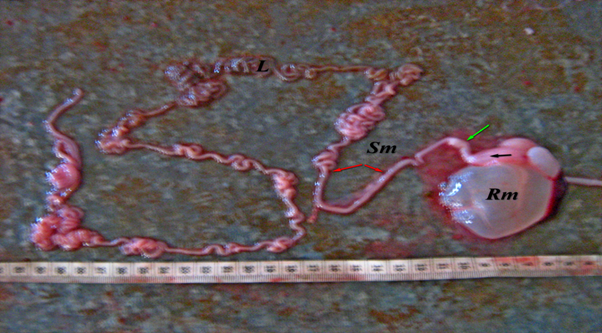
Plate 1: Photograph showing the entire digestive tract of camel fetus at first trimester
with no clear demarcation in the small intestine (Sm); ileum (Red arrow), abomasum
(Black arrow) and ileum (L), Ampullae (Green arrow), and rumen (Rm).
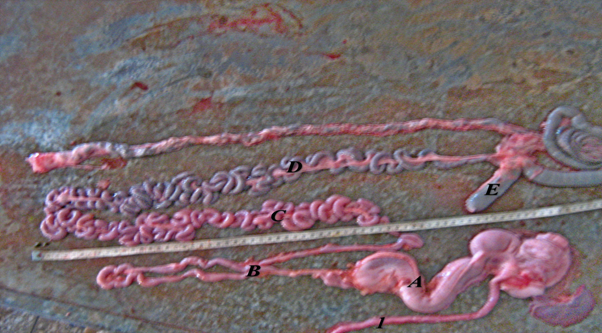
Plate 2: Photograph showing the entire digestive tract of camel fetus at third trimester
with clear demarcation in the small intestine; ileum (B), jejunum (C) and ileum (D),
oesophagus (1) caecum (E), colon (2) and rectum (3).
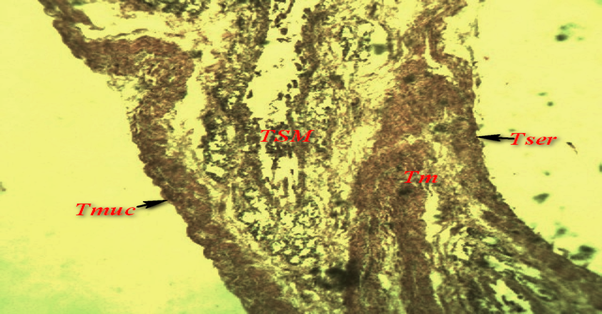
Plate 3: Transverse section of the ileum at first trimester showing Epithelium (Tmuc),
Submucosa (Tsm), tunica muscularis (Tmsc), serosa (White arrow), 150x.
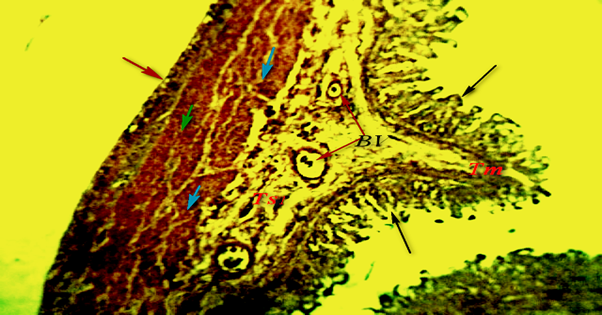
Plate 4: Transverse section of the ileum at second trimester showing Epithelium (Tmuc), Submucosa (Tsmc), internal (circular) layer of tunica muscularis (Tm2), external (longitudinal) layer of tunica muscularis (Tm1), serosa (Tser), 400x
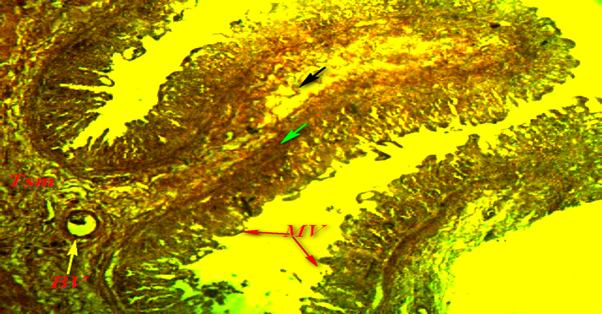
Plate 5: Transverse section of the ileum at third trimester showing keratinized stratified Epithelium (Tmuc), Submucosa (Tsmc), internal (circular) layer of tunica muscularis (Tm1), external (longitudinal) layer of tunica muscularis (Tm2), serosa (Tser), 400x
The internal mucosa of the ileum of the camel was pinkish at first trimester and greenish in color at second and third trimester, with thin longitudinal folds at the thin part and crossed longitudinal and circular folds at the ampulla. This is in line with the findings of some researchers, who reported that the internal mucosa of small intestine of other domestic animals had circular folds "Plicae Circulares" [10,11].
At first trimester, the ampulla was small and straight in shape. At second and third trimesters, the ampulla of the ileum was prominent, large and rounded in shape. The thin part was directed craniodorsally forming the cranial flexure. The study findings agree with those reported in Llama by Smuts and Benzuidenhout, [13] who concluded that the ileum begins at the pylorus which is situated on the right side below the tenth costochondal junction at second trimester.
Histologically, observation of the tissues in this study revealed a complete structure of the tubular organ. The ileum was found to consist of four layers namely: Tunica mucosa, Tunica sub mucosa, Tunica muscularis and Tunica serosa.
The distinguishing features observed in the developmental stage at tunica mucosa were, lamina epithalialis, lamina propria mucosa and lamina muscularis mucosa. At tunica muscularis the divisions were inner circular muscularis layer and outer longitudinal muscularis layer.
From the study, the epithelium of the Tunica mucosa was stratified squamous epithelium with varying degree of stratification along the length at first trimester (plate 1) and transformed to low columnar/cuboidal epithelium at second trimester (plate 2). At third trimester, the epithelium was simple columnar epithelium (plate3). Similar observations were seen on Llama [3], cow [7], sheep [6], horse [8], rodent [24], human [20], monkey [27], dog [27] and cat [18]. At first trimester, the epithelium show slight ridge of differentiation at variable intervals (Plate 3), at second trimester the ridges differentiate to form villi with less pronounce crypt of lieberkhn (Plate 4). At third trimester of age, the villi became more visible, highly vascularised with extensive network of microvilli and highly developed crypts of lieberkhum (Plate 5).
The lamina propria mucosa was found absent at first trimester but prominent at second and third trimester (plate 3 and plate 4). The Lamina mascularis mucosa was found prominent at third trimester but not identified at first and second trimester. The above finding showed that the development of the laminae of the camel’s ileum was in succession.
At first trimester of age tunica submucosa was prominent (plate 3) while at second trimester, it consisted of connective tissue cells and fibres scattered all over the layers with preliminary blood vessels. The cells and fibres were undifferentiated at this stage. There was evidence of duodenal gland found scattered within the layer (plate 4). At third trimester of age, the connective tissues and blood vessels were found prominent and the duodenal glands were found throughout the length of the ileum. The above findings were contrary to those of ruminant, horse and cat as reported by Kumar., et al. [17], which showed the presence of submucosa duodenal glands at the ampulla, descending part and caudal duodenal flexure (transverse part) region only.
This is in accordance with the finding of Qayyum., et al. [22] on Llama; Erdunchaolu., et al. [10] and Peng., et al. [19] on Bacterian camel, Emura., et al. [7] and Kumar., et al. [17] on sheep and Chamorro., et al. [4] on Horse.
The tunica muscularis of camel ileum consist of inner circular and outer longitudinal smooth muscle layers. At first trimester this layer did not differentiate into these two zones but only longitudinal orientation of smooth muscle layer (plate 3).
At second trimester, the layers of two zone with clear demarcation was observed (plate 4), while at third trimester, the inner circular layer appeared to be much thicker than the outer longitudinal layer (plate 5). The above finding was in conformity with that of Llama [9] goat [4] and buffalo foetuses [25].
A thin layer of connective tissue comprising of undifferentiated cells lined the ileum externally was observed in all the stages of development. This was observed at first trimester and became well developed at second and third trimester of age (plate 3,4 and 5).
Conclusion and Recommendations
The development of the camels’ ileum based on embryonic stage was in succession both gross and histologically. The thin part of the ileum was not divided at first trimester but differentiated into three parts; descending part, caudal duodenal flexure (transverse part) and ascending part at second trimester. The information obtained in this study will serve as a base-line data for the camel specie in this environment. There is need for thorough investigation of the features observed in the findings using electron miscroscope with standerd histological techniques to conclude on the above findinds.
Acknowledgement
I wish to show my sincere gratitude to Mr. M.I Jimoh and Mr. O. Olushola of the department of veterinary Anatomy, Faculty of Veterinary Medicine, Usmanu Danfodiyo University Sokoto, Nigeria for a job well-done in preparing the histological slide.
I wish to show my sincere gratitude to Mr. M.I Jimoh and Mr. O. Olushola of the department of veterinary Anatomy, Faculty of Veterinary Medicine, Usmanu Danfodiyo University Sokoto, Nigeria for a job well-done in preparing the histological slide.
References
- Asari M., et al. “Histological development of bovine abomasum”. Anatomischer Anzeiger 159.1-5 (1985): 1-11.
- Bal HS and Ghoshal NG. “Histomorphology of the torus pyloricus of the domestic pig (Sus scrofa domestica)”. Zentralbl Veterinarmed C 1.4 (1972): 289-298.
- Bello A., et al. “A biometric study of the digestive tract of one-humped camel (Camelus dromedarius) fetuses”.Scientific Journal of Zoology 1.1 (2012): 11-16.
- Bello A., et al. “Age estimation of camel in Nigeria using rostral dentition”. Scientific Journal of Animal Science 2.1 (2013): 9-14.
- Bustinza A.V. “South American Camelids. In: IFS Symposium Camels Sudan”. (1979): 73-108.
- Cummings JF., et al. “The mucigenous glandular mucosa in the complex stomach of two New-World Camelids, the llama and guanaco”. Journal of Morphology 137 (1972): 71-110.
- El-Wishy AB., et al. “Functional changes in the pregnant camel with special reference to fetal growth”. British. Veterinary Journal137.5 (1981): 527-537.
- Georgieva R and Gerov K “The morphological and functional differentation of the alimentary canal of pig during ontogeny. I. Development and differentation of the fundic portion of the stomach”. Anatomischer Anzeiger 137.1-2 (1975): 12-15.
- Heller R., et al. “Retention of fluid and particles in the digestive tract of the llama (Lama guanacoe f. Glama)”. Comp Biochem Physiol A Comp Physiol 83.4 (1986): 687-691.
- Hena SA., et al. “Radiographic studies of developing calvaria at prenatal stages in one-humped camel”. Sokoto Journal of Veterinary Sciences 10.1 (2012): 13-16.
- Jamdar MN and Ema AN. “The submucosal glands and the orientation of the musculature in the oesophagus of the camel”. Journal of Anatomy 135.1 (1982): 165-71.
- Luciano L., et al. “Die Struktur der Magenschleeimhaut beim Lama (Lama guanacoe and Lama llama) I. Vormägen”. Gegenbauers Morphol. Jahrb. 125(1979): 519-549.
- Malie., et al. “Anatomy of the dromedarius camel”. Clarenden press, Oxford J (1987): 101-140.
- Reece and William O. “Physiology of domestic animals. Williams and Wilkins”. (1997): 334.
- Sonfada ML. “Age related changes in musculoskeletal Tissues of one-humped camel (Camelus dromedarius) from foetal period to two years old”. A Ph.D Thesis, Department of Veterinary Anatomy, Faculty of Veterinary Medicine, Usmanu Danfodiyo University, Sokoto, Nigeria. (2008).
- Sukon P. “The Physiology and Anatomy of the Digestive tract of Normal Llamas”. PhD Thesis, Oregon State University, Corvallis. (2009).
- Umaru MA and Bello A. “A study of the biometric of the reproductive tract of the one-humped camel (Camelus dromedarius) in orthern Nigeria”. Scientific Journal of Zoology 1.5 (2012).
- Wilson R.T. “Studies on the livestock of Southern Darfur. Sudan V. Notes on camels”. Tropical Animal Health Production 10.1 (1995):19-25.
- Dellmann HD and JA Eurell. “Textbook of Veterinary Histology 5th Edition’. Lippincott Williams and Wilkins, Baltimore, USA. (1998).
- Lin JH., et al. “Is the role of the small intestine in first-pass metabolism overemphasized?” Pharmacological Reviews 51.2 (1999): 135-158.
- May NDS. “The Abdomen. In: The Anatomy of the Sheep: A Dissection Manual, May, N.D.S. 3rd Edition. University of Queensland, Queensland (1977): 67-101.
- Nakshabendi., et al. “Rates of small intestinal mucosal protein synthesis in human jejunum and ileum”. American Journal of Physiology - Endocrinology and Metabolism 277.6-1 (1999): 1028-1031.
- Perez W., et al. “Observations on the macroscopic anatomy of the intestinal tract and its mesenteric folds in the pampas deer (Ozotoceros bezoarticus, Linnaeus 1758)”. Anatomia, Histologia, Embryologia 37.4 (2008): 317-321.
- Perez, W., et al “Gross anatomy of the intestine and its mesentery in the nutria (Myocastor coypus)”. Folia Morphologica 67.4 (2008): 286-291.
- Sisson S., et al. “The Digestive System. In: Sisson and Grossman's the Anatomy of the Domestic Animals, Sisson, S., J.D. Grossman and R. Getty 5th Edition. Volume 1, 2, WB Saunders Company, Philadelphia, USA (1975).
- Smuts., et al. “The Anatomy of the Dromedary. Clarendon Press, Oxford, (1987).
- Weisbradt NW. “Motility of the Small Intestine. In: Physiology of the Gastrointestinal Tract”. Johnson L.R., J. Christense, M.J. Jackson, E.D. Jacobson and J.H. Walsh (Editions). Volume 2. Raven Press, New York, USA. (1987)
Citation:
Bello A., et al. “Fetal Differentiation of the Ileum of one Humped Camel (Camelus dromedarius):A Histomorphology”. Multidisciplinary
Advances in Veterinary Science 1.3 (2017): 82-88.
Copyright: © 2017 Bello A., et al. This is an open-access article distributed under the terms of the Creative Commons Attribution License, which permits unrestricted use, distribution, and reproduction in any medium, provided the original author and source are credited.





























 Scientia Ricerca is licensed and content of this site is available under a Creative Commons Attribution 4.0 International License.
Scientia Ricerca is licensed and content of this site is available under a Creative Commons Attribution 4.0 International License.